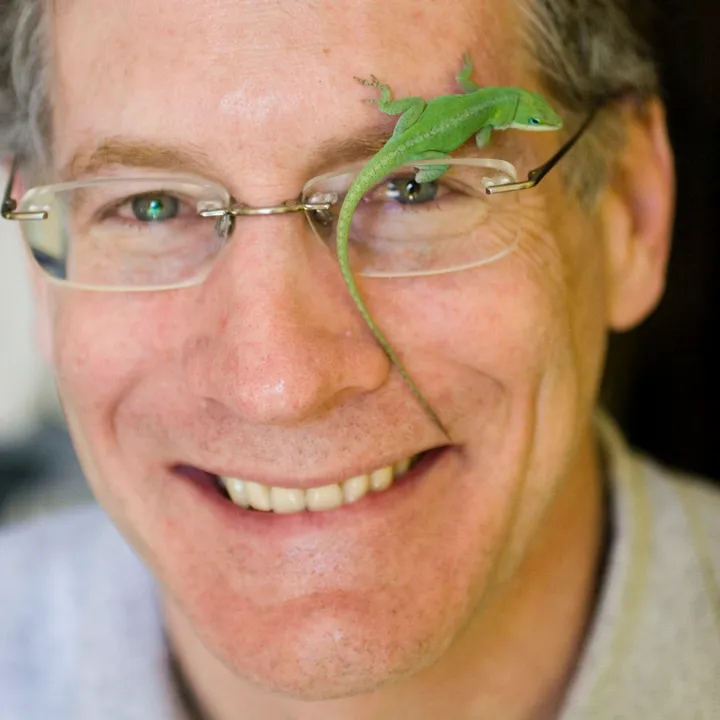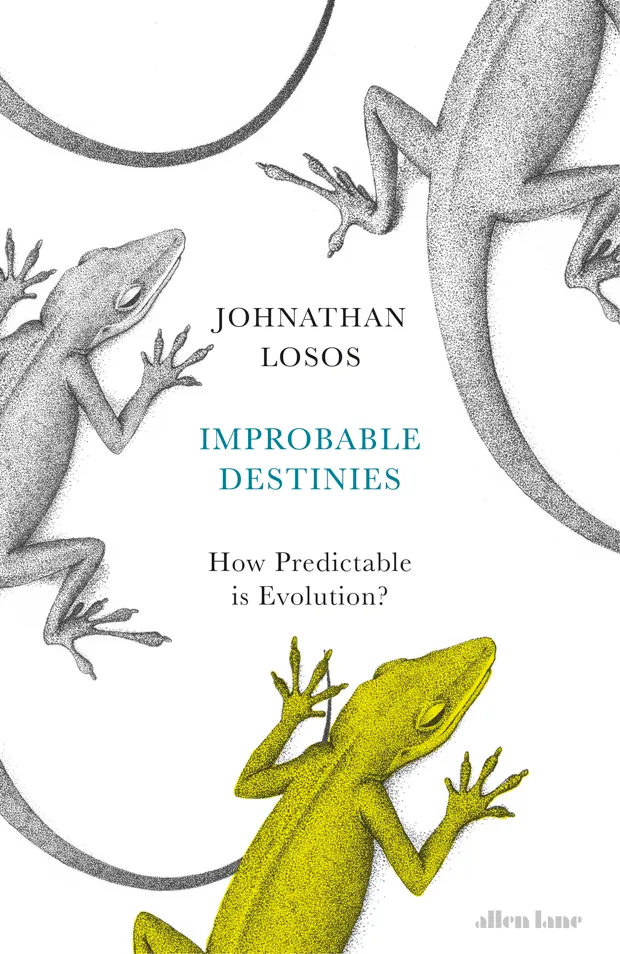If we were to replay the tape of life here on Earth from scratch, would we as humans still evolve? That’s a key question new research in the area of experimental evolution is seeking to address. We speak to Jonathan Losos, professor in the Department of Organismic and Evolutionary Biology and curator of herpetology at the Museum of Comparative Zoology, ahead of publication of his first book Improbable Destinies: How Predictable is Evolution?
Why have you decided to revisit convergent evolution?
In short, it’s new evidence. Stephen Jay Gould wrote in his seminal and highly influential book Wonderful Life that we were not fated to evolve the way we did; that if you could replay the tape of life and let evolution proceed from an early point, then the end result would not at all be the same. But Gould’s argument was based entirely on logic and thought experiments. Thirty years later, we have lots of data on how deterministic evolution is, how subject it is to the whims and flukes of history. We are finally in a position to re-assess whether Gould was right or not.
Two developments are important. Firstly, evolutionary convergence is much more pervasive than we ever realised. Cases of convergence were thought of as “exceptions” – the great examples of natural selection – but now we know it’s much more common. It may be so common it shows Gould was wrong. Evolution can do the same thing time and time again and is predictable to some extent. Secondly, we can now conduct evolutionary experiments in both the laboratory and the field. What Gould deemed impossible beyond theory is now possible. We do it in the lab all the time – when natural selection is strong, evolution proceeds very rapidly in the lab, as well as in nature. We’re now doing evolutionary experiments in the field with real animals in their natural setting.
Is evolution a fixed programme, steered only by environment and accidents?
The answer to that is somewhere in the middle, as with many debates. To some extent, if you put the same species in the same environment, experiencing the same selective pressures, they often do evolve in the same way. This is particularly common when you’re dealing with closely related species, and there’s a reason for that. Closely related species have the same genes and the same biology, so it’s very easy for them to evolve in the same way. Different species, however, have different ways of reacting to a given evolutionary pressure. So evolution is probably more deterministic than Gould was willing to recognise, but it’s not quite as pervasive as some others have argued. Where is the convergent duck-billed platypus, for example? If evolution is so convergent, why don’t we have this animal outside Australia? Evolution is often not predictable; it’s contingent on previous circumstances.
Given the time evolution takes, is that why – so far as we know – Earth is the only planet on which evolution has made progress?
I can’t really answer that question. What’s changed recently is our knowledge about how many Earth-like planets there may be, even within our own Milky Way galaxy. With the realisation that these planets exist, many people think the likelihood that life has evolved on some of them is pretty high. We haven’t detected that yet, but it may be that we just haven’t figured out how to detect it yet.
Could evolution be happening elsewhere in the Universe and can you tell from your research what it might look like?
I have no evidence to argue that one way or the other. I do think, however, that if there are millions of moons and planets out there, the likelihood seems very high. If life has evolved, my expectation is that it would not look at all like life on Earth. Who knows what sort of chemical biology it might be based on, but the building blocks of life there would almost certainly be different to some extent from here on Earth. Even here on Earth, unrelated species react in different ways. My prediction would be that life evolved on other planets will not be at all recognisable with what we have here.

Is that not counterintuitive, given widespread convergence and shared laws of physics?
In many situations here, there is more than one way to solve a problem posed by the environment. We see this all the time here on Earth when different species confronted with the same environmental circumstance find different ways to adapt. Here’s a small example: consider rodents that burrow underground. In solving the problem of how to dig a burrow, rodents have evolved at least three different ways of doing this – front claws, back claws, or even teeth in some cases. So it’s not at all guaranteed that two life forms presented with the same selection pressure will adapt in the same way.
Are we constrained in our concept of intelligent life by our own large-brained, humanoid existence?
Yes, I think we are. Our conception of life is biased by our own experience, but look at octopuses. We know they’re fairly intelligent, but their biology is completely different from ours. I’m not saying they have human-level intelligence, but they have a lot going on in their brains and they’re nothing like us.
But for a large meteorite impact, would the ‘peak’ of evolution on this planet be reptilian?
Yes. If the meteorite hadn’t slammed into Earth 66 million years ago, the dinosaurs would most likely be ruling the Earth today. Mammals would be around – they arose about the same time the dinosaurs did – but for more than 150 million years, mammals were very minor players in the global ecosystem. They were small animals basically staying in the underbrush out of the way of the dinosaurs. Had the dinosaurs not been eliminated by the meteorite, it’s reasonable to assume that mammals would have remained minor ecological characters. The dinosaurs were continuing to evolve and the largest-brained species evolved right at the end of the cretaceous period, just before they were wiped out. One could argue that dinosaurs might have evolved with bigger and bigger brains, and become smarter and smarter. I think that intelligent life could have evolved from dinosaurs, but I don’t think it would have looked much like us. As things stand, we are a peak of evolution on this planet, but not the peak. If Earth’s history had gone another way, life would have ended on a different peak.
Does the evolutionary convergence of DNA make it vital for intelligent life?
Some biochemists argue that DNA is a uniquely designed transmitter of biological information and that it, or something very like it, is a pre-requisite for the evolution of life. I suspect that view is too-narrowly focused and influenced by what we see here on Earth. It wouldn’t surprise me if there were very different molecular configurations that could serve as a template for inheritable genetic information.
Is intelligent life in any sense predestined by evolutionary processes?
No. Human mammalian evolution is the result of a long series of particular events that occurred in life’s history that didn’t need to happen – they just did. If Earth’s history had taken a different course, then something else would have evolved, not us. There is a lot of happenstance in evolution.
What has experimental evolution taught us?
The value of understanding the extent to which evolution is repeatable is that, when faced with various threats, fully convergent evolution allows us to come up with a “one-size-fits-all” strategy. For example, if microbes evolve antibiotic resistance in the same way, we can devise countermeasures that will work on all of them. Or, if endangered species are threatened with extinction in the same way and if their ability to adapt takes the same course, then we can come up with strategies that will make that adaptive course more likely. Conversely, if species come up with their own unique responses to the environment, then we can’t take the one-size-fits-all approach. We have to then study particular cases and find particular solutions that work in each case. That’s why it’s important for us to understand when evolution repeats itself and when not. What we’re finding in antibiotic resistance, for example, is that it’s a mixed bag. Some microbes do the same thing time and time again, and in those cases a common solution can be applied. In some cases, they find new ways to evolve resistance, requiring new solutions. We don’t yet understand evolutionary processes well enough to judge when a particular approach to a problem applies.
What are the next steps in your research?
The ability to do evolutionary experiments and see evolution occurring right before our eyes. Some of the most influential work around repeatable evolution has been around lab studies with E. coli. One fantastic study set up twelve populations of E.coli in identical situations and let them evolve for 30 years! One population has evolved an important adaptation not seen in any of the others. It’s a striking illustration of how evolution might often be repeatable, but also sometimes yield very different outcomes even under identical conditions. This lab work is allowing us to rigorously test the idea of how repeatable evolution is. We can now take this idea and set up experiments in nature where we expose multiple populations to the same selective conditions to see if they evolve in the same way. This work is now going on. I and my colleagues study lizards on tiny islands in The Bahamas, others study mice in the sand hills of Nebraska, all asking the question: how repeatable is evolution in nature?

Follow Science Focus onTwitter,Facebook, Instagramand Flipboard